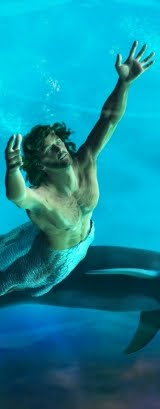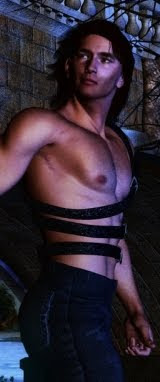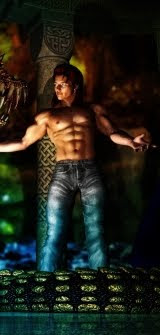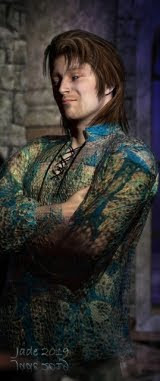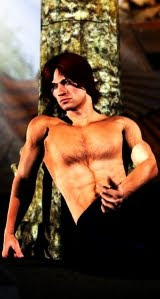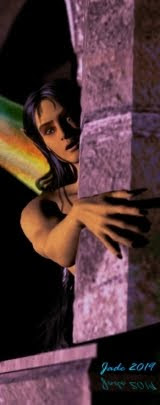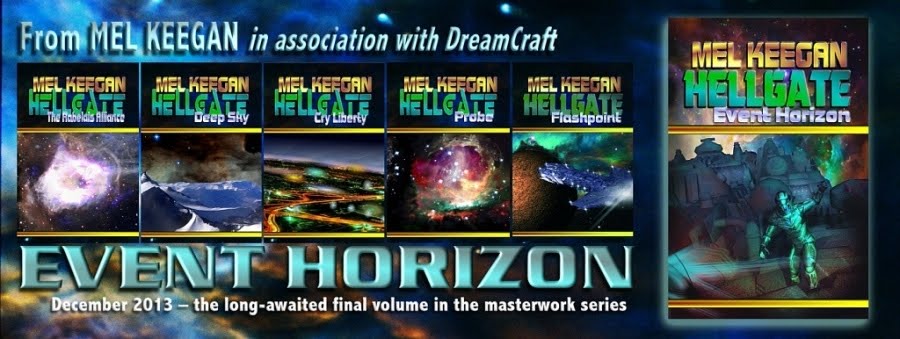Hmmmmmm. Well, no matter as I happen to have a picture of an ice dragon hatching from an egg. So now you know: They hatch from eggs. Proof:

Please click to embiggen the picture, you'll be happy!
But how did this start? It first started with me playing around in Bryce 7 Pro. I was learning the terrain sculpting tools and came up with the main "egg" and also the "top" of the "egg" overturned to the side. The material used is actually a sea ice material with some coloration changes to make it look cracky.
After that I went over to DAZ and made a cool looking Ice Dragon whilst applying various add-ons, textures, bump maps, etc to get what I wanted. I also went WAAAAY overboard on the bump mapping of the skin, horns, teeth, etc as I knew the dragon would be used in a long shot in Bryce and that Bryce has a tendency to "soften" the DAZ textures.
Here is a close up of the dragon in DAZ. Compare it to the dragon in the finished picture and you'll see why I had the bump mapping in DAZ turned up to "bloody-well high, mate!" as I knew it would soften with distance in Bryce. As always, please click to embiggen.

How's abouts them blueish sparkley things around her body, wings, egg interior and egg top? They were easy. Each one is actually a squashed sphere with a texture applied. No lights were needed and it makes for a very cool effect.
I'm going to show you a screen capture of the Bryce workspace showing the meshes for everything. You'll note that there is a squashed sphere on each wing, one large squashed sphere in the middle of the egg, and a smaller one of the egg top that's been tossed aside. Click to embiggen, of course.

The blobs on the far left and the far right are the other two eggs in the picture. I did those as object instead of terrains. Since they aren't hatched there was no reason to sculpt them, right? You may have also noticed the two yellow lights in the middle. The lower one lights up the egg interior along with the dragon body, and the other lights up the head from below. The light falloff is logarithmic so it's not "fakey" bright and the top one has a very low intensity as I only wanted it on her head. The size of the light mesh has NOTHING to do with the light itself, it just makes it easier to find in the jumble of meshes.
We'll now move to a left side view. You'll see just how far back the unhatched eggs are and you may also make note of the 2 light positions to illuminate the egg interior and the dragon properly. Make the picture larger with a click.

Notice the top red line that is just below the dragon? That's a layer of thin clouds. Go look at the very first picture and you'll notice some thin clouds just above the fog. Now you know what the red line is. It's a flat plane with a thin cloudscape applied to it. Oh, the low fog is an atmospheric effect so there's no mesh to see for it.
The top view is interesting as you'll see two things. The unhatched eggs aren't in the shot cus they are soooooooo far back. I made them huge and placed them waaaay back for two reasons. One is that the haze atmospherics will be more visible and the other is so the "eggy" textures look right. Small sized ones placed just behind the main egg DO NOT give the illusion of depth. Trust me, I tried.
The other thing to notice is that the terrain texture appears flat from above since you are viewing the terrain as a mesh. Valuable little tidbit to keep in mind, that is. Don't forget to click the pic.

I'm going to give you a cool shot of the back of the Ice Dragon rendered in DAZ. Why? Because I think the tiger strips look sooooooo cool! I think it looks neat at full size. Do I need to tell you how to bring the pitcher up to full size? No, didn't think so.

The last bit of nuts n blots for you: I made the scene on my old, decrepit P4 with 2 gigs of ram and a crappy video card. It was rendered on a modern quad core with 4 gigs built in ram, 4 gigs external ram, and a 1 gig video card. It still took 7 hours to render! Why? The sea ice texture used for the eggs is very complex (so's the blue sparkley stuff) and we cranked the rendering options sky high. However, if I had it set for total, top-of-the-line rendering it would have taken DAYS on the quad core. Just another example of software ALWAYS being light-years ahead of hardware. Well, at least affordable hardware.
Bye for now, time to go make some planets.
cheers,
dave
http://alaskandavedownunder.blogspot.com/





















